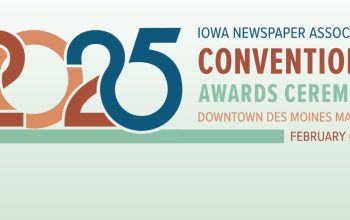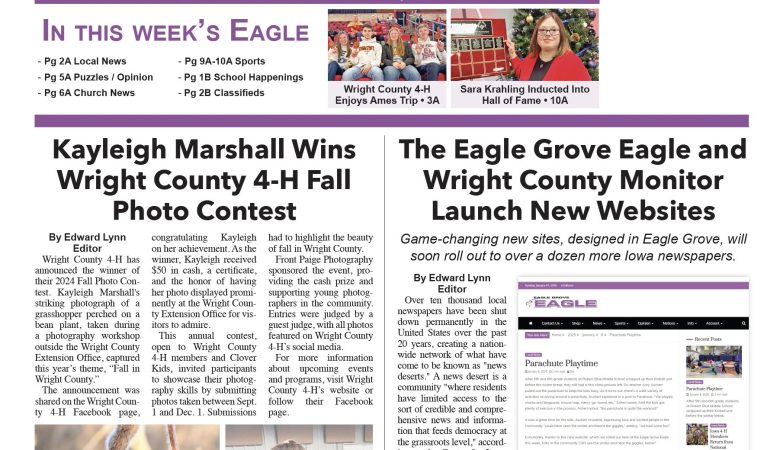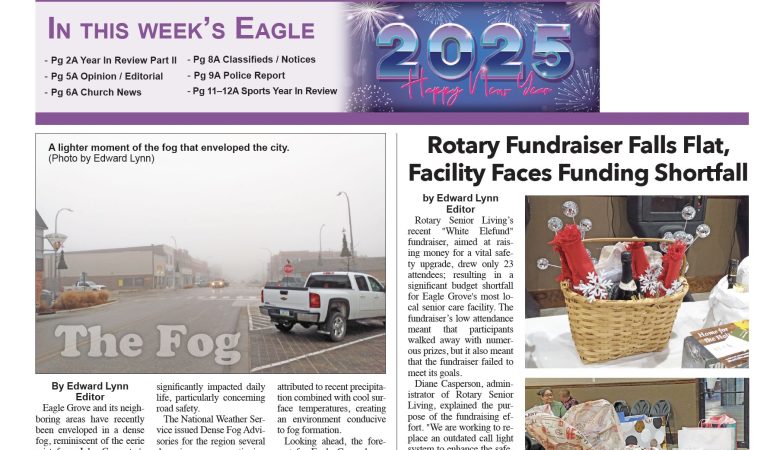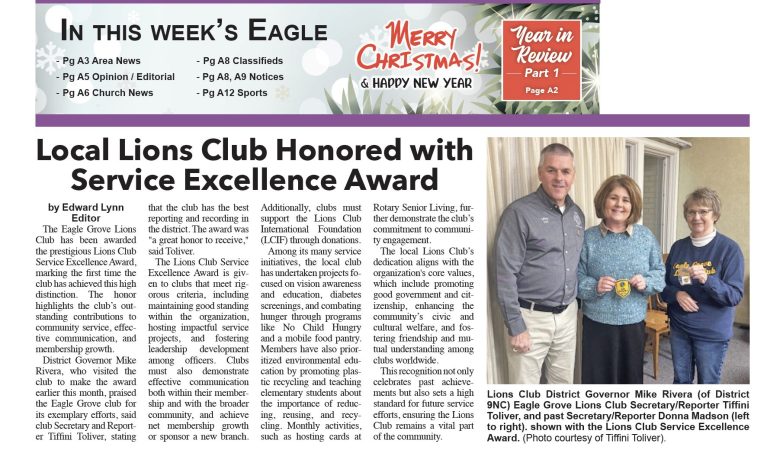Part 1 of 2
Construction has been underway on the 2020 Streetscape project since last week. According to City Administrator Bryce Davis, the funding mechanism is the primary driver of this project of the entire redevelopment strategy for the 100 – 300 block of Broadway.
The surprise start
Eagle Grove City Administrator Bryce Davis and Eagle Grove Chamber Director Sara Middleton were just as surprised by the Monday morning, March 29 construction start on the Streetscape projects as the rest of the community.
“It just sort of happened that it started right now, or it could have been delayed,” she explained. “I’ll take the slight inconvenience of right now. Let’s do it. Let’s not wait another year…so let’s jump at this chance to keep the momentum going in Eagle Grove,” she said.
Davis added that before the project started, a pre-construction meeting was held between the city and all involved parties. At that time, the city requested a construction schedule from the main contractor. They got that on Thursday, March 25. They also requested a newsletter with necessary information be drafted which was done late that next day. By the time they came to hand them out to affected businesses Monday morning, March 29, roads were already being shut down for work to begin.
The City anticipated that equipment and staging items would be delivered to the site on Monday with work beginning on Wednesday, March 31.
“With the nice weather, they really ramped up over the weekend,” said Davis. “Our concern on Monday morning came down to detours for truck traffic, because there was a detour that was put into place that was not conducive to semi truck traffic, we needed to get that modified right away…so trucks weren’t going down residential streets,” said Davis.
Their next concern was needing information from the weekends dye-sewer testing to identify active lines.
“But now we’re rolling,” said Davis.
The strategy of the Streetscape project
“The strategy really comes down to four main points,” said Davis. “The first is you need structurally sound and safe downtown buildings so that you can house residents as well as operate stores and create that downtown vibrancy.”
To do this, the city went after a downtown revitalization Facade Grant, as well as some other state funding mechanisms, to be able to put that money into the repair of our existing downtown buildings.
“So we are renovating seven buildings this summer that will start shortly,” explained Davis. “We started a little bit of work last year, but we will definitely ramp up in the May timeframe.”
They will concentrate on tuckpointing, mortar, and window replacements (which are on backorder since COVID). It’s all part of the first step to look at the existing building stock and figure out ways to incentivize local investments and state resources to be able to create an area where they can establish new businesses, maintain existing businesses, and work towards increasing upper-story housing.
Davis said upper-story housing is important because it takes approximately $80,000 for a single-family lot in a new subdivision (not including the cost of building a house). At today’s construction prices, the most economical 1,200 square foot house you can really build will cost around $170,000. Most will run upwards of $200,000. When you look at a redevelopment, you have roughly $22,000 in a lot plus the cost of a rebuild. Apartments cost about $100,000 to $105,000 a door. But when you look at upper-story housing, what they’re really doing is building a building within a building, and that comes down to only $60,000 – $65,000 a door, so it makes sense to utilize this space above business/retail structures when they can access grant money to help pay for the outside shells of the buildings.
“Once you start creating the ability to attract businesses and residents downtown, then you need to look at the streetscape in front of those buildings,” said Davis.
Are the sidewalks safe? How are the trees and stormwater runoff?
“It’s been 40+ years since downtown has been revamped,” said Davis of Eagle Grove. “So we have a lot of older structures…and we’re starting to see some aging of the concrete, crumbling concrete, and the curbs are starting to deteriorate which makes the pedestrian walkways a little more hazardous.”
When you look at all of these things, you start asking, how will it be paid for? Because Eagle Grove invested in a new water reclamation facility, the city was able to receive a grant for $1.5 million of free money used for green infrastructure which will be applied to the stormwater runoff. The city plans to use it to put in green plant vegetation to help purify the water and help with nutrient reduction.
Other things the city looked at was how to get rainwater out of town faster to avoid standing water and flooding.
“That’s where the permeable pavers come into place,” said Davis.
That too will help with nutrient reduction. These two things will cost more than the $1.5 million grant received, but they were able to also get a Community Block Grants for an additional $600,000 to help pay for this large portion of the Streetscape project.
“We have $2.1 million of essentially free money for this project,” said Davis.
The above mentioned $1.5 million can also be used to pay for pavement removal. It doesn’t, however, allow funding for the replacement of pavement. That money will come from a CBDG Grant. The city has also received a $100,000 grant from the Iowa Department of Agriculture and Land Stewardship. This will pay for the water quality initiative projects. So that essentially comes down to $2.2 million of free funding to pay for the renovations. The city’s contribution to this project includes the underground infrastructure (water lines and sewer lines), manhole replacements/installations through SRF loans; street repairs/patches and asphalt coming paid for with money from city road use taxes and local sales option taxes – the goal is not to increase individual taxes.
The second part of the strategy is to create an attractive area that has the overall vision to complete upper-story housing and interior renovations of the downtown buildings.
“Obviously we’re investing a lot of resources into our community core so we want to make sure they’re filled and vibrant,” said Davis.
Once the streetscape is done and the building work is done, the fourth step is to fill them.
“The third and fourth pillar of our plan is attacking those measures through different funding sources,” said Davis. “The why (do the Streetscape projects) from a City standpoint, is it’s created a hazardous condition, it’s unattractive, and we can leverage the free resources that we’ve received… to be able to invest in the future of Eagle Grove. The funding source is available so this is a perfect parlay into creating a catalyst for more movement.”
What’s next?
This week crews will be focusing on sanitary and water lines, replacing curb stops, and going to individual buildings to do replumbing if needed. MidAmerican will be doing some work, including moving a pole.
“We’re going to work one block at a time and every block will have two phases,” said Davis.
Phase 1A is the interior of the road.
Phase 1B is the sidewalks that are adjacent to the buildings.
They will open streets as they finish. They are anticipating service lines for the 300 block to take about two weeks, weather permitting, to bring in the water and sewer. Water will not have to be shut off unless they are directly hooking up your building, which will take between two and three hours. The contractor will contact businesses who this applies to.
After that they will remove more pavement, start excavating where the pavers will go, put in storm drains, start paving, and do sidewalks. Trees/vegetation will not go in until a later date when all three blocks of work are done.
Editor’s Note: Watch for more on this story in next week’s Eagle Grove Eagle.






